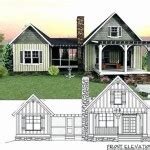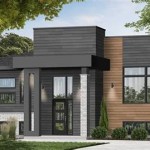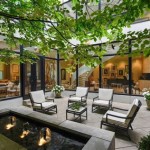A modern house plan encapsulates a design philosophy that seeks to create functional, visually appealing living spaces while incorporating the latest advancements in technology and sustainable practices. These plans often emphasize clean lines, open floor plans, and an abundance of natural light. A notable example is Frank Lloyd Wright’s Fallingwater, which seamlessly integrates the home with its natural surroundings, showcasing the defining characteristics of modern house plans.
Modern house plans deviate from traditional designs by embracing innovative materials and construction techniques. They prioritize energy efficiency, often featuring sustainable elements such as solar panels and rainwater harvesting systems. This approach aims to minimize environmental impact while reducing operating costs.
The following sections will delve deeper into the key aspects, benefits, and considerations of modern house plans. We will explore their design principles, technological advancements, and how they can enhance both the aesthetics and functionality of your living space.
Consider these key points when exploring modern house plans:
- Open floor plans
- Sustainable materials
- Energy efficiency
- Natural light
- Clean lines
- Smart technology
- Indoor-outdoor living
- Customizable designs
- Unique architectural features
- Emphasis on functionality
These elements contribute to the distinctive character and of modern house plans.
Open floor plans
Open floor plans are a defining characteristic of modern house plans. They eliminate traditional walls and partitions, creating a spacious and interconnected living area that seamlessly combines the kitchen, dining room, and living room. This design concept fosters a sense of openness and flow, allowing for greater interaction and natural light penetration.
Open floor plans offer several advantages. They promote a more social and interactive living environment, as family members and guests can easily move and communicate between different areas. Additionally, the absence of walls enhances natural light distribution, reducing the need for artificial lighting and creating a brighter and more inviting space.
Modern house plans with open floor plans often incorporate large windows and glass doors to further enhance the connection to the outdoors. This design strategy blurs the boundaries between indoor and outdoor living, allowing for seamless transitions between the two. By incorporating outdoor elements such as patios and decks, open floor plans extend the living space beyond the confines of the house.
Despite their advantages, open floor plans may require careful planning to maintain a sense of separation and privacy. Strategic placement of furniture, rugs, and other design elements can create designated areas for different activities, ensuring both functionality and a sense of intimacy. Additionally, thoughtful consideration should be given to acoustics and noise control to prevent sound from carrying throughout the open space.
Sustainable materials
Modern house plans prioritize the use of sustainable materials that minimize environmental impact and promote occupant well-being. These materials are carefully selected for their durability, energy efficiency, and ability to create a healthy indoor environment.
One key aspect of sustainable materials in modern house plans is their ability to reduce energy consumption. Materials with high thermal insulation properties, such as cellulose insulation made from recycled paper or sheep’s wool, help maintain a comfortable indoor temperature while reducing the reliance on heating and cooling systems. Additionally, energy-efficient windows and doors minimize heat loss and gain, further contributing to energy savings.
Sustainable materials also contribute to improved indoor air quality. Low-VOC (volatile organic compound) paints and finishes release minimal harmful emissions, creating a healthier living environment. Natural materials like bamboo and cork are hypoallergenic and can help reduce allergens and irritants in the air. By incorporating sustainable materials, modern house plans promote the well-being of occupants by providing a healthier and more comfortable living space.
The use of sustainable materials in modern house plans extends beyond environmental and health benefits. These materials often offer unique aesthetic qualities that enhance the overall design of the home. For example, reclaimed wood can add a rustic touch while also reducing the environmental impact associated with deforestation. Sustainable materials can also be used to create visually striking features, such as accent walls made from recycled glass or countertops crafted from bamboo.
By embracing sustainable materials, modern house plans not only reduce environmental impact and promote well-being but also contribute to the overall aesthetic appeal of the home. These materials offer a range of benefits, from energy efficiency and improved indoor air quality to unique design possibilities.
Energy efficiency
Energy efficiency is a cornerstone of modern house plans, with a focus on reducing energy consumption and minimizing environmental impact. This is achieved through a combination of passive and active design strategies that work together to create a home that is both comfortable and sustainable.
Passive design strategies harness natural resources to reduce energy consumption. These strategies include:
- Building orientation: Positioning the house to take advantage of natural sunlight and prevailing breezes helps regulate indoor temperature, reducing the need for artificial heating and cooling.
- Insulation: High-performance insulation in walls, ceilings, and floors minimizes heat loss and gain, maintaining a comfortable indoor temperature year-round.
- Windows and doors: Energy-efficient windows and doors with double or triple glazing and low-e coatings reduce heat transfer, preventing heat loss in winter and heat gain in summer.
- Natural ventilation: Cross-ventilation and stack ventilation techniques utilize natural airflow to cool the house and reduce reliance on air conditioning.
Active design strategies incorporate technology to further enhance energy efficiency. These strategies include:
- Solar panels: Photovoltaic panels convert sunlight into electricity, reducing reliance on the grid and generating renewable energy.
- Energy-efficient appliances: Appliances with Energy Star ratings consume less energy, reducing overall electricity consumption.
- Smart home systems: Automated systems can control lighting, heating, and cooling based on occupancy and preferences, optimizing energy usage.
- Geothermal heat pumps: These systems use the stable temperature of the earth to heat and cool the home efficiently.
By integrating both passive and active design strategies, modern house plans achieve exceptional energy efficiency, resulting in lower energy bills, reduced environmental impact, and a more comfortable living environment.
Natural light
Natural light plays a crucial role in modern house plans, influencing both the aesthetics and functionality of the living space. Architects carefully consider the placement and size of windows and skylights to maximize natural light penetration, creating a bright and inviting atmosphere while reducing the need for artificial lighting.
- Enhanced mood and well-being: Natural light has been shown to have a positive impact on mood, energy levels, and overall well-being. Exposure to sunlight can boost serotonin production, which is associated with feelings of happiness and reduced stress.
- Reduced energy consumption: By utilizing natural light during the day, modern house plans can significantly reduce the need for artificial lighting, leading to lower energy consumption and cost savings.
- Improved indoor air quality: Natural ventilation through windows and skylights promotes air circulation, reducing indoor air pollution and improving air quality for occupants.
- Increased visual comfort: Natural light provides balanced and glare-free illumination, reducing eye strain and creating a more comfortable visual environment.
Modern house plans often incorporate large windows and glass doors to maximize natural light penetration. These large glazed areas not only flood the interior with light but also provide scenic views of the outdoors, creating a connection between the indoor and outdoor spaces. Additionally, skylights placed strategically bring natural light into areas that may not have direct access to windows, such as bathrooms, hallways, and interior rooms.
Clean lines
Clean lines are a defining characteristic of modern house plans, contributing to their minimalist and sophisticated aesthetic. This design principle emphasizes simplicity, clarity, and order, resulting in a visually pleasing and functional living space.
- Visual harmony: Clean lines create a sense of visual harmony and balance, as the eye can easily follow and appreciate the uncluttered forms and spaces.
- Spaciousness: The absence of unnecessary ornamentation and clutter allows for a more spacious and airy feel, making the home appear larger and more inviting.
- Functionality: Clean lines often translate into functional spaces, as the focus on simplicity and order eliminates distractions and promotes efficient use of space.
- Timelessness: Modern house plans with clean lines tend to have a timeless quality, as they are not tied to specific trends or styles, making them enduringly attractive.
Architects achieve clean lines through various design elements, such as:
- Geometric forms: Simple geometric shapes, such as squares, rectangles, and circles, are often used to create clean lines and define spaces.
- Minimalist details: Unnecessary details, moldings, and embellishments are eliminated, allowing the clean lines of the architecture to take center stage.
- Neutral color palettes: Neutral colors, such as white, black, and gray, are commonly used to create a clean and sophisticated backdrop for the clean lines.
- Open floor plans: Open floor plans, with minimal walls and partitions, enhance the sense of spaciousness and allow for uninterrupted sight lines, reinforcing the clean lines of the design.
Smart technology
Smart technology plays a significant role in modern house plans, transforming homes into intelligent and responsive living spaces. By integrating advanced technologies, homeowners can enjoy increased convenience, efficiency, security, and entertainment.
One key aspect of smart technology in modern house plans is home automation. Automated systems allow homeowners to control various aspects of their home remotely using smartphones, tablets, or voice assistants. These systems can manage lighting, heating, cooling, and even security systems, providing unparalleled convenience and energy savings.
Smart home appliances are another integral part of smart technology in modern house plans. Refrigerators that monitor food inventory and suggest recipes, ovens that can be preheated remotely, and washing machines that send notifications when laundry is complete are just a few examples of how smart technology enhances everyday tasks.
Smart security systems provide peace of mind and enhanced protection for modern homes. These systems often include motion sensors, door and window sensors, and security cameras that can be monitored remotely. Homeowners can receive alerts or notifications in case of any suspicious activity, allowing them to respond promptly.
Indoor-outdoor living
Modern house plans seamlessly integrate indoor and outdoor living spaces, creating a cohesive and inviting environment that extends the living area beyond the confines of the house.
- Expansive windows and doors: Large windows and glass doors blur the boundaries between indoor and outdoor spaces, allowing for natural light to flood the interior and providing stunning views of the surrounding landscape.
- Outdoor living areas: Patios, decks, and balconies extend the living space outdoors, creating additional areas for relaxation, dining, and entertainment. These outdoor areas are often designed with comfortable seating, outdoor kitchens, and fire pits to enhance the outdoor living experience.
- Transitional spaces: Sunrooms, conservatories, and screened porches serve as transitional spaces between the indoor and outdoor environments. They provide protection from the elements while still allowing for a connection to nature.
- Landscaping design: Landscaping plays a crucial role in creating a cohesive indoor-outdoor living experience. Native plants, water features, and outdoor lighting can enhance the visual appeal and extend the living space into the surrounding environment.
By incorporating indoor-outdoor living concepts, modern house plans offer a unique and enriching lifestyle that promotes a connection to nature, enhances well-being, and creates a harmonious living environment.
Customizable designs
Modern house plans prioritize customizable designs that cater to the unique needs and preferences of homeowners. This flexibility allows for homes to be tailored to specific lifestyles, family dynamics, and personal tastes.
- Modular designs: Modular designs utilize prefabricated components that can be combined and arranged in various ways, providing flexibility in creating custom floor plans. This approach allows for homes to be easily adapted to different site conditions and space requirements.
- Open floor plans: Open floor plans eliminate traditional walls and partitions, creating large, open spaces that can be customized to suit individual needs. Homeowners can define different areas within the open space using furniture, rugs, and other design elements, allowing for flexibility in room layout and functionality.
- Multi-purpose spaces: Modern house plans often incorporate multi-purpose spaces that can serve various functions depending on the homeowner’s needs. These spaces can be easily transformed from a home office to a guest room or a playroom, providing adaptability and efficient use of space.
- Universal design features: Universal design features, such as wider doorways, accessible bathrooms, and ramps, can be incorporated into modern house plans to enhance accessibility and comfort for individuals with disabilities or as people age.
Customizable designs in modern house plans empower homeowners to create living spaces that truly reflect their individual style and needs, ensuring a comfortable, functional, and personalized living environment.
Unique architectural features
Modern house plans embrace unique architectural features that enhance the aesthetics, functionality, and overall character of the home.
Asymmetrical facades
Asymmetrical facades challenge traditional symmetry, creating visually striking and dynamic exteriors. These facades feature unbalanced arrangements of windows, doors, and other architectural elements, resulting in a unique and eye-catching appearance. Asymmetrical facades allow architects to break away from conventional designs and create homes that stand out from the crowd.
Curved walls and roofs
Curved walls and roofs introduce organic forms into modern house plans, creating a sense of fluidity and movement. These curved elements can be used to define spaces, create unique visual effects, and add a touch of whimsy to the home. Curved walls can form cozy alcoves or dramatic entryways, while curved roofs can add a touch of elegance and intrigue to the exterior.
Floor-to-ceiling windows
Floor-to-ceiling windows offer expansive views of the surrounding landscape and flood the interior with natural light. These large windows create a seamless connection between the indoor and outdoor spaces, blurring the boundaries and bringing the beauty of nature into the home. Floor-to-ceiling windows can be used to create stunning living areas, dining rooms, or bedrooms with panoramic views.
Cantilevered structures
Cantilevered structures extend a portion of the building beyond its supporting elements, creating a sense of lightness and floating. These structures can be used to create balconies, terraces, or even entire rooms that seem to defy gravity. Cantilevered structures add a dramatic architectural element to the home and can provide stunning views from elevated positions.
These unique architectural features are just a few examples of the innovative and visually appealing design elements that can be incorporated into modern house plans. By embracing asymmetry, curves, expansive windows, and cantilevered structures, architects create homes that are not only aesthetically pleasing but also functional and distinctive.
Emphasis on functionality
Modern house plans prioritize functionality to create living spaces that are not only aesthetically pleasing but also practical and efficient. This emphasis on functionality is reflected in various design elements and features that enhance the overall usability and comfort of the home.
- Open floor plans: Open floor plans eliminate traditional walls and partitions, creating large, interconnected spaces that promote seamless flow and interaction. This design approach allows for multiple activities to occur simultaneously, fostering a sense of openness and togetherness. Open floor plans also maximize natural light penetration, reducing the need for artificial lighting.
- Multi-purpose spaces: Modern house plans often incorporate multi-purpose spaces that can serve various functions depending on the homeowner’s needs. These spaces can be easily transformed from a home office to a guest room or a playroom, providing adaptability and efficient use of space. This flexibility allows homeowners to customize their living environment to suit their changing needs and lifestyle.
- Smart storage solutions: Modern house plans integrate smart storage solutions to maximize space utilization and maintain a clutter-free environment. Built-in shelves, hidden compartments, and customized storage units are strategically placed throughout the home to accommodate various items, from clothing and accessories to books and electronics. These storage solutions enhance the functionality of the home by keeping belongings organized and easily accessible.
- Accessible design features: Modern house plans often incorporate accessible design features to ensure that the home is comfortable and convenient for individuals of all ages and abilities. These features include wider doorways, ramps, and accessible bathrooms, promoting inclusivity and ease of movement. By considering accessibility, modern house plans create living spaces that are not only functional but also welcoming to all.
The emphasis on functionality in modern house plans extends beyond these specific design elements. It encompasses a holistic approach to home design that prioritizes the needs and preferences of the occupants, creating living spaces that are not only stylish but also practical, adaptable, and enjoyable.










Related Posts








